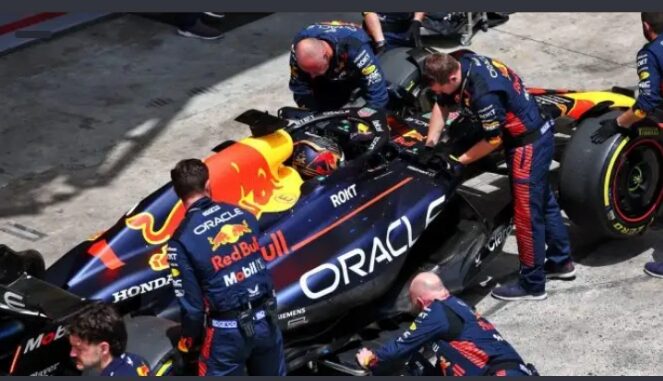
It often seems as if the technology transfer between Formula 1 machines and road cars has lessened year after year, but according to Ford CEO Jim Farley, that road relevance is exactly why the American company wants to enter F1.
At a season launch for Ford Performance, the motorsport division of the road-car company, CEO Jim Farley touched on its partnership with Red Bull Racing and its decision to join F1 as a power-unit manufacturer for 2026.
As expected, Farley set some lofty goals and assured the audience that Ford is on track with its F1 development program. However, he also noted that technology transfer — a seemingly outdated concept — has actually played a huge role in Ford’s decision to enter the sport.
In fact, Farley has compared this upcoming ruleset to those developed throughout the 1970s.
We’re going back to F1 in a way that we haven’t in the past,” Farley said. “It turns out that the best aerodynamics in the world are in Formula 1, the best telemetry, the best digital diagnostics. And, actually, we need all those things for electric cars. So it’s actually going back to the ’70s with a pure tech transfer.”
While F1 used to be considered a hotbed for automotive innovation, its relevance to road-car production has faded as technology grew more complex and materials more expensive.
Now, if F1 tech makes it to a consumer car, it’s generally an ultra-expensive supercar like the Mercedes-AMG ONE. Gone are the days of simple transfers, like paddle shifters, steering wheel buttons, or active suspension.
Farley, however, raises a compelling point. In 2026, new regulations will require half of an F1 car’s energy to come from electric power, which will result in a far more robust hybrid system – something that Ford already has experience with.
Ford will be able to offer Red Bull a welcome slew of advice based on road cars like the Ford F-150 Lightning, the Mustang Mach-E, and the company’s hybrid versions of models like the Fusion, Escape, and Explorer.
In return, Red Bull will push Ford’s power units to the maximum in conditions that are impossible on a regular American highway; that may just give Ford a leg up over domestic auto competitors and establish itself as a key player in the international game.
We’re going [to F1] literally to transfer technology,” Farley reiterated. “We can offer battery tech [to Red Bull] … and, on the other hand, we can get telemetry, digital diagnosis, as well as aero, which we can put into our production electric cars to make the battery smaller.”
If Ford wants to improve its electric tech, why wouldn’t it go to Formula E – a series that’s 100% electric – instead?
Farley didn’t directly address this concern, but there are several likely factors at play. Formula E is, in many significant ways, a spec series. Each team is required to utilise a large set of standardised components, and modifications to non-spec parts are strictly limited by cost caps.
There isn’t a space for significant manufacturer development in FE, and especially not compared to F1, even as F1 limits development and spending.
Further, Formula E doesn’t quite have the same profile as F1. Ford is likely investing in F1 under the assumption that reintroducing its name to the global stage will put its name in front of more buyers in more markets.
FE doesn’t have that same level of appeal, nor has it attracted the kind of world-class minds that Red Bull has found in Adrian Newey.
Ford, of course, has had past experience with tech transfer in F1. It remains the third-most successful engine manufacturer in F1 history, thanks in large part to its partnership with Cosworth Racing and the DFV engine that partnership produced.
By teaming up with Red Bull, Ford is once again looking to fast-track its way into the motorsport history books.
Leave a Reply